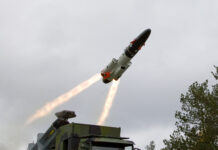Troops, vehicles and other equipment can be transported to the beach by a variety of means including helicopters, landing craft, hovercraft and amphibious assault vehicles (AAVs). This article concentrates mainly on the latter.
Getting to the Beach
While some armoured fighting vehicles (AFVs) do have an amphibious capability, such as the Russian BMP-1, BMP-2 and BMP-3 infantry fighting vehicles (IFVs), this is limited to rivers and lakes. In the past some countries, including the United Kingdom, fitted their vehicles with floatation screens. For example, these included all members of the Alvis Scorpion family of Combat Vehicle Reconnaissance (Tracked) and the Swedish S-tank.
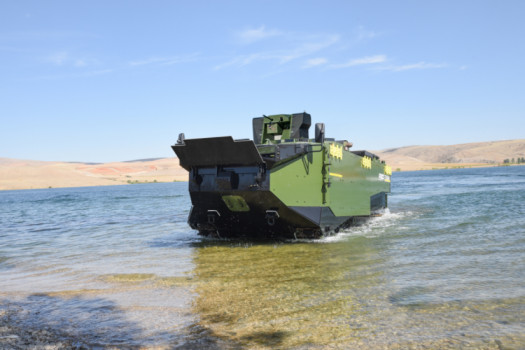
These floatation screens were carried retracted around the top of the hull and erected when required, but in the end all of these were removed. Some AFVs were also fitted with bags which are inflated for crossing rivers and lakes. A good example is the South Korean K21 IFV. Its flotation bags are folded in travel mode and inflated as soon as the vehicle goes into the water for amphibious operations.
All these devices are very vulnerable, not only to small arms fire but also to damage from objects floating in the water. Moreover, they are considered dangerous even in peace time training, as vehicles and their crews have been lost.
Getting out of the water is the main challenge for amphibious vehicles. Inland water operations involve steep riverbanks and fast flowing rivers. Vehicles that are launched offshore have to cope with the effects of wind, tide and currents. Crossing the surf line may also pose some risk while in some parts of the world coral reefs may have to be overcome.
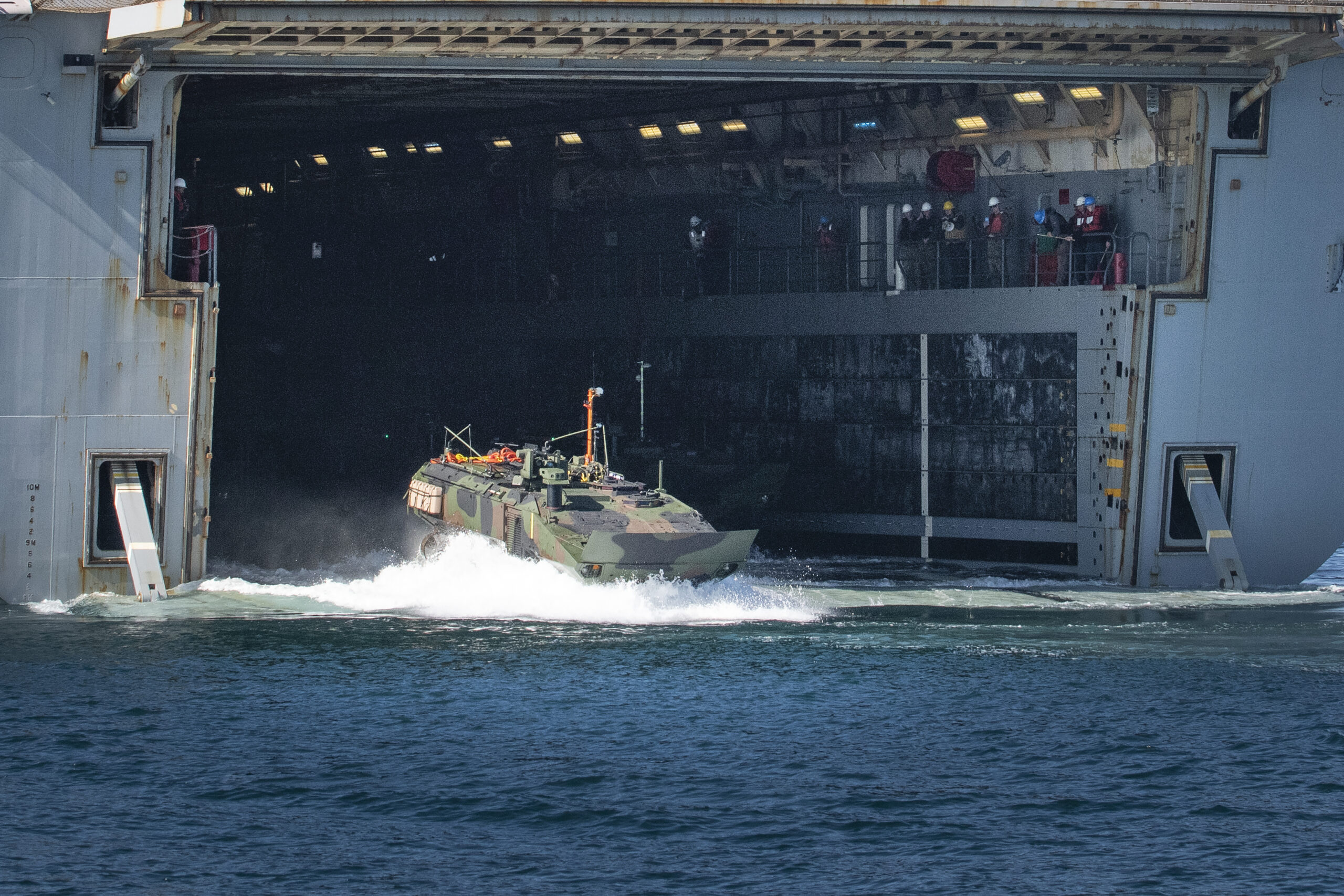
Key Players
USA
For many years the standard amphibious assault vehicle used by Western countries has been the US BAE Systems AAV7A1, which was originally developed by the then FMC Corporation as far back as 1965/1966. The first production vehicles were completed in 1972 at the San Jose facility and called the Landing Vehicle, Tracked, Personnel, Model 7 (LVTP7). This was later changed to Amphibious Assault Vehicle 7 (AAV7). Beyond the US Marine Corps, it is also used by Argentina, Brazil, Italy, Japan, South Korea (local production), Spain, Taiwan, Thailand and Venezuela, amongst others.
The baseline AAV7A1 has a crew of three and can carry 25 Marines who can rapidly dismount through the power operated ramp at the rear. Armament comprises a one-man turret armed with a 40 mm automatic grenade launcher (AGL) and a 12.7 mm machine gun.
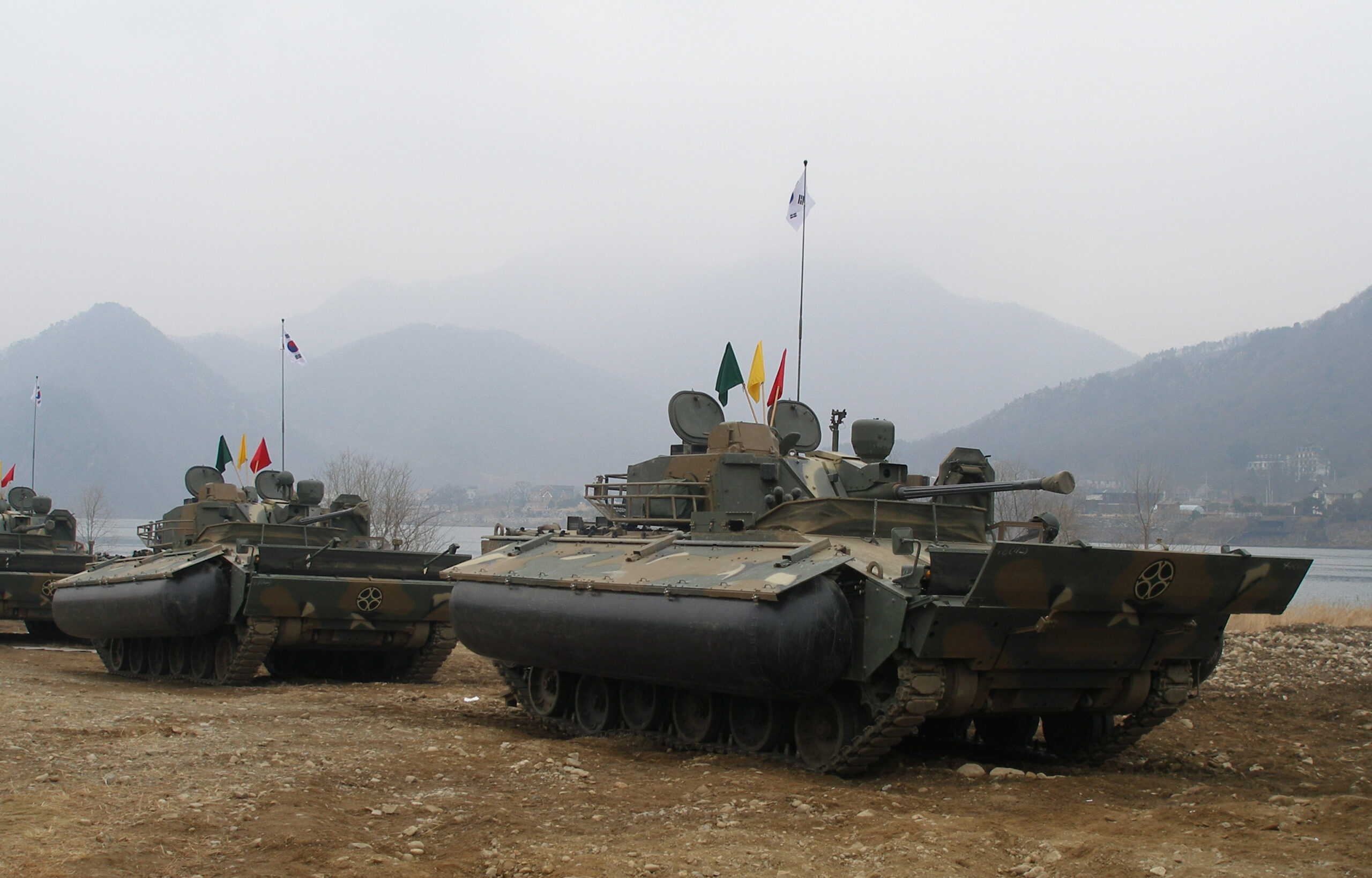
bags in position on the sides and front. (Photo: Doosan)
Specific versions of the AAV7 are the AAVC7 command vehicle and AAV7R recovery vehicle. Moreover, prototypes of further specialised vehicles included a variant for mine clearance and one fitted with a turret mounted 105 mm gun. Over the years the US Marine Corps AAV7 and variants were upgraded on a number of occasions to extend their operational lives and include the AAV7A1. SAIC were awarded a contract to upgrade these through the AAV Survivability Upgrade (AAV-SU) but in the end this programme was cancelled after a few prototypes were completed.
In March 2023 the US Defense Security Cooperation Agency notified Congress of the possible sale of AAVs to Greece with a total value of USD 268 M. This included 63 AAVP-7A1s, nine AAVC-7A1s, and four AAVR-7A1s plus weapons, support and training. BAE Systems would not confirm as to whether these are new build vehicles or upgrades of older ones.
In a statement to MDM Garrett Lacaillade, Vice President of Amphibious Programmes at BAE Systems, said “BAE Systems is committed to supporting the US Government and allied partners by providing critical capabilities to aid them in achieving their priority missions, AAVs will provide a long proven amphibious capability supporting the Hellenic Army’s mission and protecting Greece’s maritime interests.”
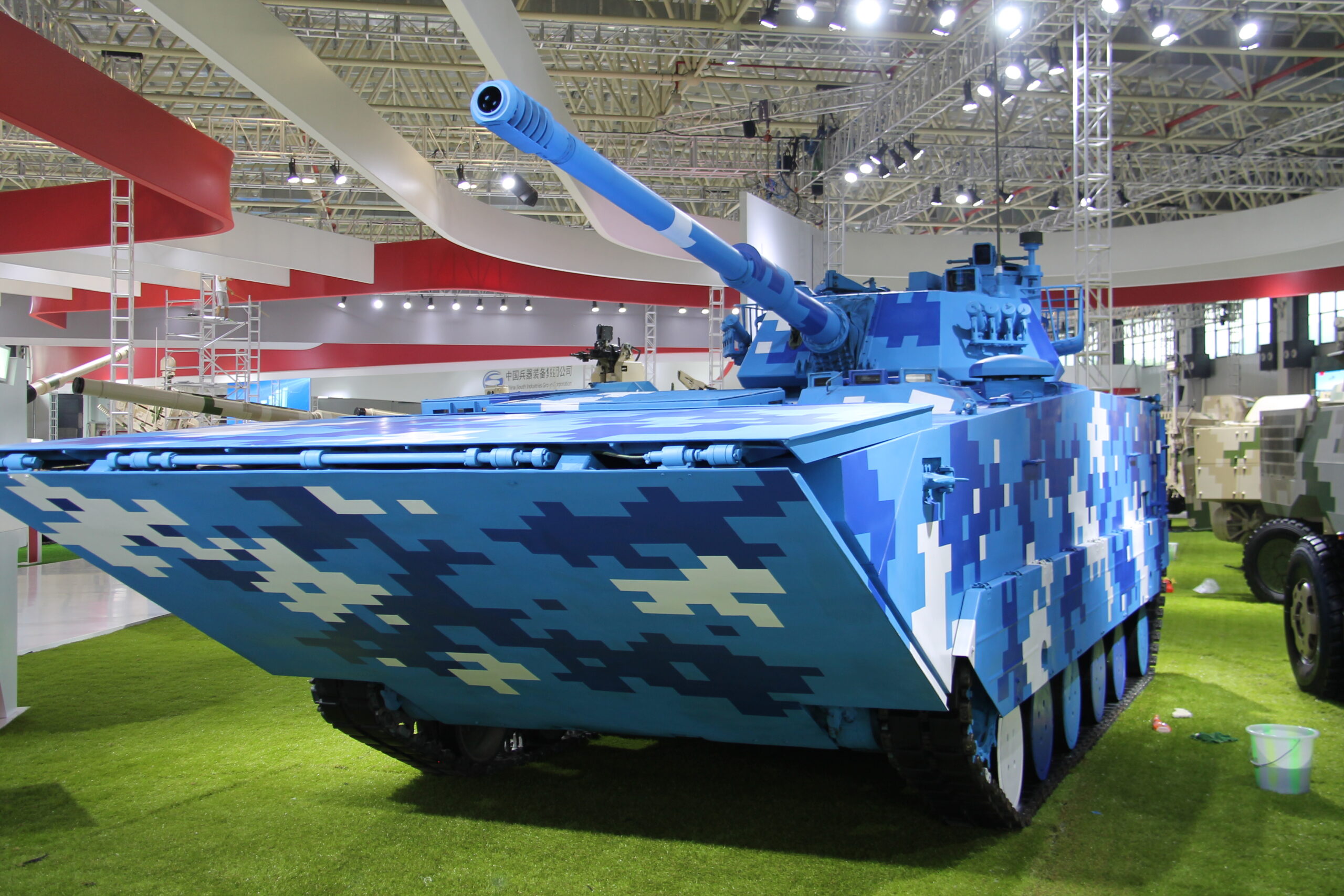
It was expected that the AAV7A1 would be replaced by the General Dynamics Land Systems Advanced Amphibious Assault Vehicle (AAAV), subsequently renamed the Expeditionary Fighting Vehicle (EFV). It was designed for a maximum WATER speed of 25 kn and, in addition to a crew of three, could carry 17 Marines. It was fitted with a remote weapon station armed with a Northrop Grumman 30 mm MK44 Mod 1 dual feed cannon and a 7.62 mm machine gun. However, this was ultimately cancelled in 2011 due to cost and reliability issues.
Following cancellation of the EFV, the US Marine Corps ran a competition for a less sophisticated and costly marine personnel carrier (MPC). SAIC and BAE Systems were ultimately shortlisted for this contract. SAIC proposed a vehicle based on the Terrex from Singapore and BAE Systems offered an IDV (formerly Iveco Defence Vehicles) SuperAV (8×8). After trials between prototypes, BAE Systems was selected.
The MPC is now called the Amphibious Combat Vehicle (ACV) and the US Marine Corps approved full rate production in 2021 for the first variant, the ACV-P. It is already being delivered to US Marine Corps units. The second version to enter production is the command version, ACV-C which will be delivered in 2023. BAE Systems is also under contract for the ACV-R (Recovery) and the ACV-30. The latter will be fitted with a Kongsberg remote controlled turret armed with a 30 mm cannon and 7.62 mm machine gun.
Turkey
The Turkish FNSS Savunma Sistemleri, jointly owned by BAE Systems (49%) and Nurol of Turkey (51%), could have manufactured the US AAV7A1 under licence. Instead, the company developed a new vehicle to meet the specific requirements of Turkey for a vehicle to be deployed from its new amphibious assault ship (LHD) TCG Anadolu. This is called the Marine Assault Vehicle (MAV), or ‘Zaha’. Like the US AAV7A1 it is propelled whilst afloat by two waterjets positioned one either side at the rear, just above the suspension. These provide a maximum water speed of 7 kn. Before entering the water, the trim vane is hydraulically extended at the front of the hull and the bilge pumps activated.
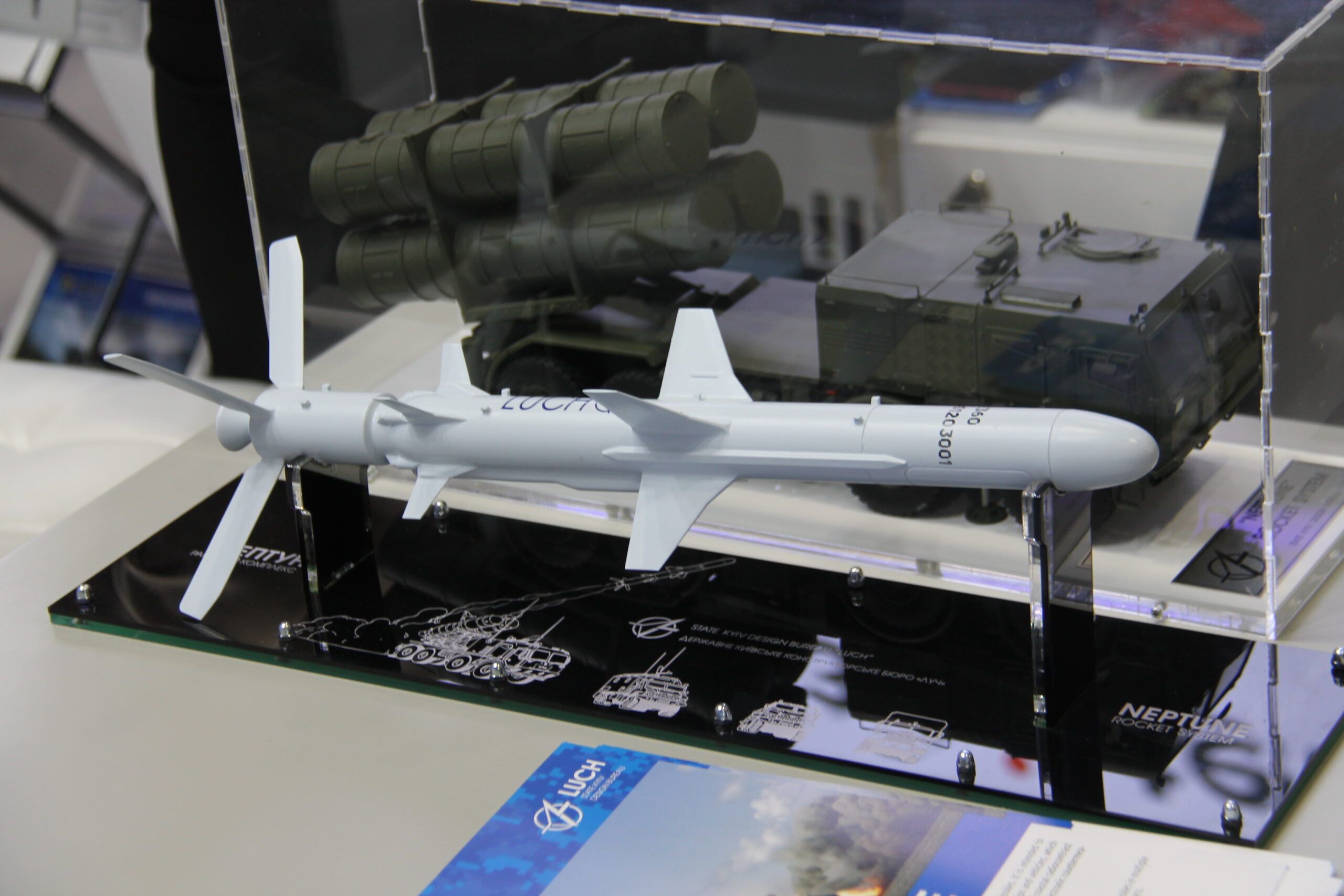
deployed by the Ukraine.(Photo: Christopher F Foss)
The MAV’s power pack consists of a Cummins diesel coupled to an Allison fully automatic transmission which gives a maximum land speed of up to 70 km/h. The power-to weight ratio is 20 hp/tonne. For comparison: the Leopard 2A7 has a ratio of 22.22 hp/tonne, the Leopard2A1 27 hp/tonne, the Chieftain MBT 13.63 hp/tonne.
The hull is of all welded aluminium armour with add-on ceramic armour plates. According to FNSS, the vehicle’s most significant distinguishing feature, which differentiates the vehicle from its predecessors, is its ballistic and mine protection capability. Mounted on the roof is a Caka remote weapon station (RWS) developed by FNSS. It comprises a laser rangefinder, a stabilised 40 mm AGL and a 12.7 mm machine gun. Standard equipment for the MAV also includes a smoke generator. Together with smoke grenade launchers, this provides a capability for smoke screening.
The MAV also has a communications/battle management system and situational awareness cameras, whilst an LI/LLTV image fusion camera can provide vision to the driver in conditions of complete darkness with depth and terrain detail. Life support equipment includes a fire detection and suppression system, a NBC system, as well as heating and air conditioning.

A total of 27 production MAVs had been completed by 2022, of which 23 were in the armoured personnel carrier (APC) variant. In addition to its crew of commander, gunner and driver, it can carry 21 men who can rapidly leave via a power operated ramp in the rear. In addition four dedicated versions have been delivered: two command post and two repair and recovery variants. The crane fitted to the recovery vehicle is situated on top of the hull and is capable of lifting the complete power pack when required. As the MAV’s design is flexible, other versions could be developed for particular purposes, such as mine clearance.
The MAVs are operated by the Turkish Naval Command’s Amphibious Marine Brigade. FNSS is also trying to market the MAV internationally. It is, for example, a potential replacement for some of the older vehicles deployed by the Indonesian Marines. The Turkish company is well placed in Indonesia as they are working with the local company of PT Pindad on the Kaplan Medium Tank (MT), locally called the Harimau.

France
For many years the standard infantry fighting vehicle of the French Army was the Giat (today Nexter) AMX-10P. To meet the requirements of export customers a specialised version was developed called the AMX-10P Marines. It was sold to Indonesia (34) and Singapore (44) in different variants.
China
While the US Marine Corps cancelled their EFV, China has pushed ahead and fielded significant numbers of similar vehicles. Indeed, these are already being offered on the export market by Norinco (China North Industries Corporation).
The baseline version is called the VN18 ‘Tracked Amphibious Infantry Fighting Vehicle’. It has a crew of four, consisting of commander, gunner, loader and driver and can carry 11 personnel who can rapidly leave via a ramp at the rear. The turret is armed with a 30 mm cannon and a 7.62 mm co-axial machine gun. A HJ-73D anti-tank guided weapon (ATGW) is mounted on either side. The power pack consists of a 4-stroke water-cooled turbo charged diesel developing 440 kW on land and 1,176 kW whilst afloat. Maximum land speed is being quoted as 65 km/h. When afloat, the vehicle is propelled by two water jets – positioned one either side at the rear – which give a maximum speed of up to 25 km/h. It has a gross vehicle weight of 28.5 tonnes. Before entering the water the bilge pumps are activated, the trim vane extended at the front of the hull and the adjustable hydro pneumatic suspension raised to reduce drag.
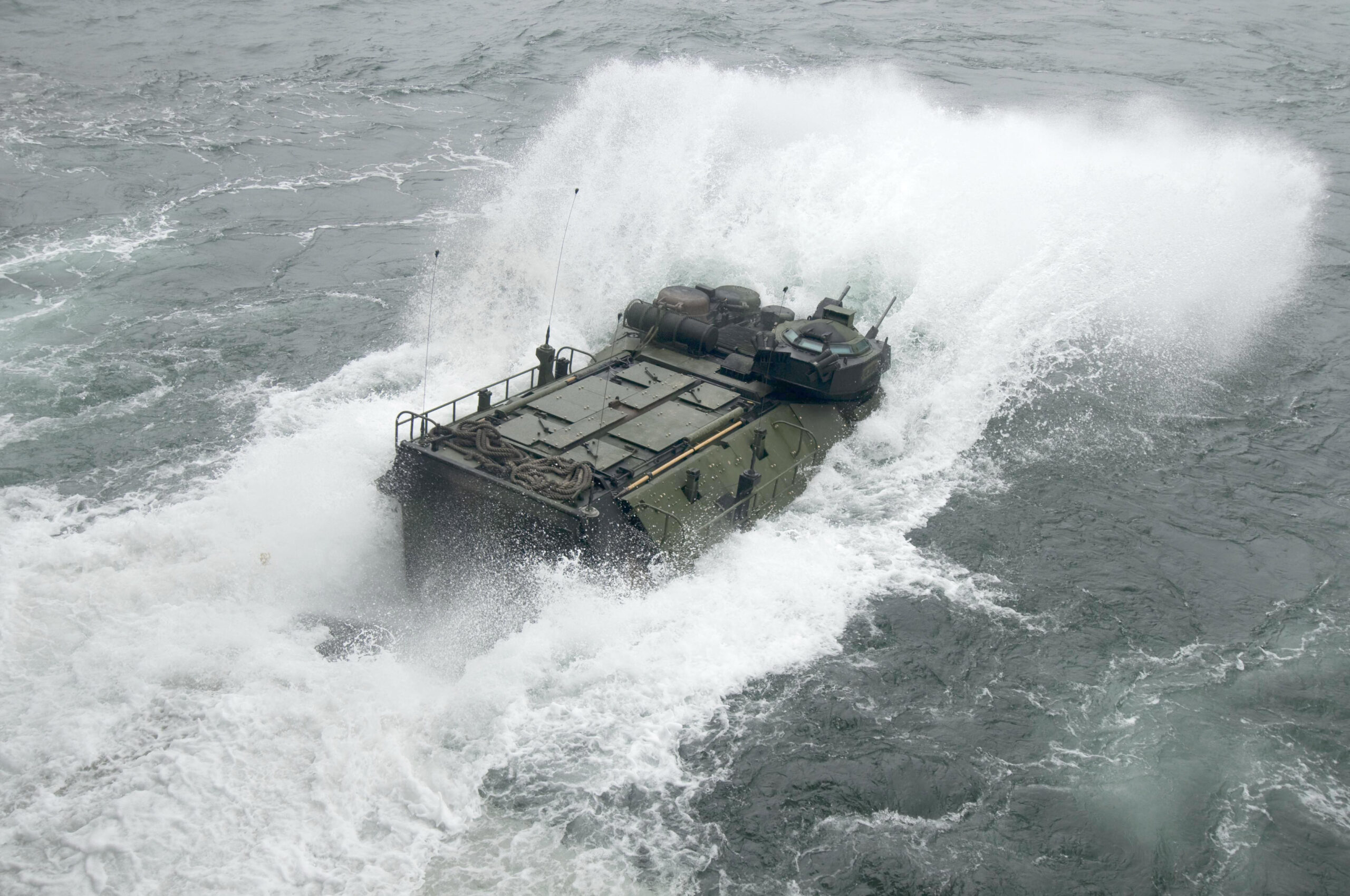
The VN16 has a similar hull to the VN18 and is called a ‘Tracked Amphibious Assault Vehicle’. It is fitted with a three-person turret armed with a 105 mm low recoil rifled gun, 7.62 mm co-axial machine gun and a roof mounted 12.7 mm machine gun.
Both vehicles have a welded aluminium hull with applique armour which provides protection from small arms fire and shell splinters
Japan
Japan purchased some AAV7A1s from the US but is now pushing ahead with its own AAV. In some respects, the design is similar to the cancelled US EFV. A number of testbeds have already been completed. The vehicle is expected to weigh around 40 tonnes, be powered by a V-12 diesel developing 3,000 hp and be propelled by water jets. Other features will include in-arm suspension which can be raised for amphibious operations, composite rubber tracks and an extendable trim vane at the front.
Other Amphibious Vehicles
IDV has developed the ‘Veicolo Blindato Anfibio’ (VBA) using internal research and development funding and based on experience with their SuperAV 8×8 vehicles. Compared to them, the VBA has increased buoyancy. In the water it is propelled by two propellers situated one either side at the rear. The power pack consists of an Iveco FPT ‘Curso’ 16 engine developing 700 hp coupled to an automatic transmission. When afloat, the vehicle is powered by two hydraulically operated propellers which – according to IDV – give it a top speed of 6 knots and a capacity of operating beyond Sea State 3.
Late in 2022 IDV were awarded a contract by the Italian Director of Land Armaments covering the supply of 36 VBAs for the Italian Navy. These will be fitted with a Leonardo Hitrole. The remote-controlled weapon system is armed with a 12.7 mm machine gun. According to IDV, the vehicle is supposed to reinforce the fleet of San Marco Marine Brigade and will effectively increase national sea projection capability.
In addition to these specialised vehicles, some mainstream AFVs are simply adapted for amphibious operations when necessary, typically through additional buoyancy. Other AFVs have a, built-in integral amphibious capability. A typical example is the Brazilian Guarani (6×6) which is already in production for the home and export markets. In the water, it is propelled by two propellers mounted at the rear.

Defending the Beach
The days of well protected beaches have long gone, with the USA scrapping its coastal guns just after the Second World War and the UK having disbanded coastal artillery in 1956, apart from some guns defending the Straits of Gibraltar.
The Nordic countries invested heavily in fixed coastal artillery batteries. Finland, Norway and Sweden all had fixed coastal guns, with the latter two including the Bofors ‘Ersta’ 120 mm turret mounted weapons. Denmark had older turret mounted guns. Sweden had 20 batteries equipped with three, turret-mounted 75 mm rapid fire guns coupled to a computerised and radar supported fire control system. All of these have now been decommissioned.
Other countries deployed truck-mounted coastal defence missile systems using
MBDA Exocet and Otomat missiles, as well as the Swedish Saab RBS 15 and the US Harpoon. In the Falkland Islands campaign Argentina used trailer-mounted Exocet missiles to damage the Royal Navy County class destroyer HMS Glamorgan. Subsequently the UK deployed trailer mounted Exocet missiles to defend the straights of Gibraltar. This role was subsequently taken over by Spain with its General Dynamics European Land Systems Santa Barbara Sistemas 155 mm 155/52 APU SBT towed artillery systems optimised for the coastal defence.
Other short-range missiles were also deployed by some countries, such as the Hellfire two-round launcher that is still used by Sweden. China and Russia deployed coastal defence systems based on missiles as well as mobile guns.
Ukraine has developed and deployed Neptune (360ST), a coastal defence missile which supposedly hit the Russian cruiser RFS Moskva in the Black Sea in 2022. The truck mounted system has four missiles which are elevated to fire position. The missiles have a nose mounted active guidance seeker and are claimed to have a maximum range of over 300 km.
The Norwegian Kongsberg Naval Strike Missile was originally developed to be launched from surface ships. However, is now being marketed for coastal defence operations. These include use by the US Marine Corps, with the missiles being strapped to a Joint Light Tactical Vehicle.
Early in 2023 Romania ordered the coastal defence version which is called the Naval Strike Coastal Defense System under a contract which will eventually be worth up to USD 217 M. It is understood that the contract covers the supply of two batteries, each with four mobile launchers. In turn, each launcher has four missiles mounted on a cross-country truck. There is an associated command control system. Prior to launch, the launchers are elevated.
Christopher F Foss







